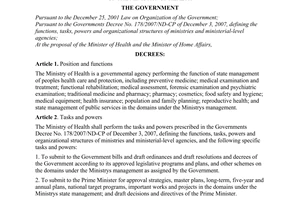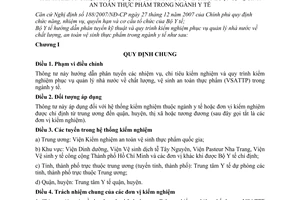Nội dung toàn văn Circular 13/2011/TT-BYTdecentralization tasks testing indicators procedures food quality safety hygiene
|
THE MINISTRY OF HEALTH |
SOCIALIST REPUBLIC OF VIETNAM |
|
No. 13/2011/TT-BYT |
Hanoi, March 31, 2011 |
CIRCULAR
ON DECENTRALIZATION OF TASKS, TESTING INDICATORS AND TESTING PROCEDURES FOR STATE MANAGEMENT IN TERMS OF FOOD QUALITY, SAFETY AND HYGIENE IN THE HEALTH SECTOR
Pursuant to the Government's Decree No. 188/2007/ND-CP dated December 27 2007, defining the functions, tasks, powers and organizational structure of the Ministry of Health;
The Ministry of Health provide guidelines for technical-based decentralization and testing procedures for state management in terms of food quality, safety and hygiene in the health sector as follows:
Chapter I
GENERAL PROVISIONS
Article 1. Scope
This Circular provides guidelines for decentralization of tasks, testing indicators and testing procedures for state management in terms of food quality, safety and hygiene (food safety and hygiene) in the health sector.
Article 2. Regulated entities
This Circular applies to the testing system of the health sector or testing units assigned from the central to districts or equivalent (hereinafter referred to as testing units).
Article 3. Levels in the testing system
a) Central level: National Institute for Food Control;
b) Regional level: Institute of Nutrition, Central Highlands Institute of Hygiene and Epidemiology, Nha Trang Pasteur Institute, Institute of Hygiene and Public Health of Ho Chi Minh City and other units appointed by the Ministry of Health;
c) Province or central-affiliated city level (hereinafter referred to as province level): Preventive health centers of provinces;
d) District level: Medical centers of districts.
Article 4. General responsibilities of testing units
1. Be subject to specialized- and technical-related monitoring in the testing of food quality, safety and hygiene of the superior levels and competent authorities.
2. Initiate specialized-related tasks according to decentralization serving the state management in terms of food quality, safety and hygiene, including:
a) Management, inspection, complaints, and denunciation;
b) Regular or irregular testing of samples in terms of food quality, safety and hygiene;
c) Investigation and determination of reasons for food poisoning and hazards in terms of food quality, safety and hygiene.
3. Annually, inferior testing units must report their competence of testing to superior testing units.
Chapter II
DECENTRALIZATION OF TESTING TASKS SERVING MANAGEMENT OF FOOD QUALITY, SAFETY AND HYGIENE
Article 5. Testing units of district level
1. Collect samples for testing or sending to superior levels for the purposes of:
a) Monitoring of food contamination hazards;
b) Inspection of food safety and hygiene;
c) Investigation of reasons for food poisoning and foodborne diseases.
2. Use quick testing techniques to conduct qualitative analysis of indicators related to food quality, safety and hygiene.
3. Instruct health facilities of communes to take samples for testing at facilities processing and trading food and beverage services.
4. Release statistics and send reports on regular or irregular testing or testing as requested to the superior level.
Article 6. Testing units of province level
1. Apply and standardize analysis methods using in laboratories.
2. Collect samples for testing or sending to superior levels for the purposes of:
a) Monitoring of contamination hazards of food produced and sold on the market of provinces, including imported food;
b) Inspection of food safety and hygiene;
c) Inspection of food quality, safety and hygiene;
d) Investigation of reasons for food poisoning and foodborne diseases.
3. Instruct testing units of districts to take samples for testing for the purposes of: monitoring and inspection in terms of food quality, safety and hygiene of facilities producing, processing and providing food and beverage services.
4. Release statistics and send reports on regular or irregular testing or testing as requested to the superior level.
Article 7. Testing units of region level
1. Apply and standardize analysis methods using in laboratories.
2. Act as central unit or take charge of taking sample and testing for the following purposes:
a) Inspection of food quality, safety and hygiene;
b) Monitoring of contamination hazards of food produced and sold on the market of regions as assigned, including imported food;
c) Inspection of food safety and hygiene;
d) Investigation of reasons for food poisoning and foodborne diseases.
3. Provide guidance on techniques for testing of food quality, safety and hygiene for provinces in the assigned regions.
4. Take charge and cooperate in formulation of test methods, and research new analysis techniques and standardize testing techniques.
5. Provide training courses to improve professional qualifications for testing workers of provinces in the assigned regions.
6. Carry out assessment of technical competence of laboratories in terms of food quality, safety and hygiene.
7. Release statistics and send reports on regular or irregular testing or testing as requested to the superior level.
Article 8. Testing units of central level
National Institute for Food Control acts as a central unit in terms of testing for state management in terms of food quality, safety and hygiene:
1. Be a verification unit in charge of testing of food quality, safety and hygiene.
2. Take charge of developing a single testing method that is presented to competent authority for issuance.
3. Carry out assessment of technical competence of laboratories in terms of food quality, safety and hygiene.
4. Participate in assessment of hazards in terms of food safety and hygiene.
5. Provide training courses in improvement of technical competence for testing units of levels.
6. Release statistics and send regular and irregular reports on results of testing, competence of testing of the system to the regulatory agencies of food quality, safety and hygiene.
7. Establish standard substances and reference standards serving the testing of food quality, safety and hygiene.
Chapter III
DECENTRALIZATION OF TESTING INDICATORS
Article 9. Testing units of district level
Conduct quick testing for screening of indicators in connection with food quality, safety and hygiene before sending them to superior levels.
Article 10. Testing units of province level
Conduct food testing techniques for:
1. Nutrient indicators;
2. Additives and processing aids;
3. A number of heavy metals and minerals;
4. Microorganisms, parasitology;
5. Chlorine-containing or phosphorus-containing pesticide residues;
6. Other indicators according to competence.
Article 11. Testing units of regional level
1. Conduct food testing techniques for:
a) Conduct testing techniques prescribed in Article 10 of this Circular;
b) Analyze natural toxins, microbial toxins, fungal toxins and toxic chemicals in food, antibody.
2. Research and develop new testing techniques in testing of food quality, safety and hygiene.
Article 12. Testing units of central level
1. Conduct food testing techniques for:
a) Conduct testing techniques prescribed in Article 10 of this Circular;
b) Genetically modified foods and irradiation.
2. Research testing techniques in testing of food quality, safety and hygiene.
Chapter IV
TESTING PROCEDURES
Article 13. Receipt of testing samples
1. Inspect status and condition for sample storage.
2. Receipt and consider requirements for testing:
a) Testing indicators on samples;
b) Minimum amount of samples for each sampling;
c) Time for testing results;
d) In the case where one or more indicators exceed the testing competence of the testing units, the samples shall be considered sending to the superior level;
dd) Upon the change of requirements for testing, the unit sending samples shall notify the testing unit of the change in writing.
3. The sample must be encoded and included in the receipt book.
4. The sample shall, if not being analyzed immediately, be stored in the appropriate condition.
Article 14. Sample testing
1. The sample to be tested must be in container, under appropriate storage, with clear and untorn code.
2. The analysis of the sample must be conducted according to the test methods as prescribed.
Article 15. Storage of samples
1. The sample to be stored must be in appropriate condition.
2. Time for storage: according to request of the sending unit provided that not exceeding 12 months from the receipt date.
Article 16. Responsibilities of testing units
1. The head of testing unit shall take legal responsibility for the testing results.
2. Send testing reports to superior levels and competent authorities.
Chapter V
IMPLEMENTATION
Article 17. Effect
This Circular comes into forces from June 1, 2011.
Article 18. Implementation
Department of Food Safety and Hygiene shall implement this Circular.
Difficulties that arise during the implementation of this Circular should be reported to Department of food safety and hygiene affiliated to the Ministry of Health for consideration./.
|
|
PP. MINISTER |
------------------------------------------------------------------------------------------------------
This translation is made by LawSoft and
for reference purposes only. Its copyright is owned by LawSoft
and protected under Clause 2, Article 14 of the Law on Intellectual Property.Your comments are always welcomed

